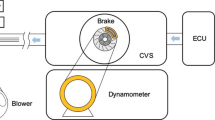Abstract
Non-exhaust PM10 emissions are coming increasingly into focus of both regulation and media coverage. This will in coming years pose a challenge to the mobility sector as a whole and to the automobile industry in particular. To master this challenge, an in depth knowledge of the underlying processes of particle generation and emission is needed. As a contribution to this effort, the present study investigates the influence of different friction materials and disc types on brake emissions. It show that a well-performed brake emission measurement on a brake dynamometer can provide valuable information about both basic influencing factors and material-specific emission behavior. The results clearly indicate a correlation between the mass of PM10 emissions and total wear as well as a temperature dependency of the number of emitted particles (PN emissions) for grey cast iron brake discs. It is shown that coated discs have the ability to significantly reduce PN emissions especially in the small particle size range. The presented measurement method and evaluation strategy enables future friction material development that is aiming at low emission brake systems.
Access this chapter
Tax calculation will be finalised at checkout
Purchases are for personal use only
Similar content being viewed by others
References
Denier van der Gon H, Gerlofs-Nijland M, Gehrig R, Gustafsson M, Janssen N, Harrison R, Hulskotte J, Johansson C, Jozwicka M, Keuken M, Krijgsheld K, Ntziachristos L, Riediker M, Cassee F (2013) The policy relevance of wear emissions from road transport, now and in the future. J Air Waste Manage Assoc 63:136–149
Asbach C, Todea AM, Zessinger M, Kaminski H (2019) Generation of fine and ultrafine particles during braking and possibilities for their measurement. In: XXXVII international μ-Symposium 2018 brake conference. Springer, Berlin, pp 143–164
Mathissen M, Grochowicz J, Schmidt C, Vogt R, Farwick zum Hagen FH, Grabiec T, Steven H, Grigoratos T (2018) A novel real-world braking cycle for studying brake wear particle emissions. Wear 414-415:219–226
Breuer B. (2012) Bremsenhandbuch. 4th edn. Springer Fachmedien, Wiesbaden
Grigoratos T, Martini G (2015) Brake wear particle emissions: a review. Environ Sci Pollut Res 22:2491–2504
Hagino H, Oyama M, Sasaki S (2016) Laboratory testing of airborne brake wear particle emissions using a dynamometer system under urban city driving cycles. Atmos Environ 131:269–278
Perricone G, Matějka V, Alemani M, Valota G, Bonfanti A, Ciotto A, Olofsson U, Söderberg A, Wahlström J, Nosko O, Straffelini G, Gialanella S, Ibrahim M (2018) A concept for reducing PM10 emissions for car brakes by 50%. Wear 396–397:135–145
Kaminski H, Kuhlbusch TAJ, Rath S, Götz U, Sprenger M, Wels D, Polloczek J, Bachmann V, Dziurowitz N, Kiesling HJ, Schwiegelshohn A, Monz C, Dahmann D, Asbach C (2013) Comparability of mobility particle sizers and diffusion chargers. J Aerosol Sci 57:156–178
Keskinen J, Pietarinen K, Lehtimäki M (1992) Electrical low pressure impactor. J Aerosol Sci 23:353–360
Farwick zum Hagen FH, Mathissen M, Grabiec T, Hennicke T, Rettig M, Grochowicz J, Vogt R, Benter T (2019) Study of brake wear particle emissions: impact of braking and cruising conditions. Environ Sci Technol. https://doi.org/10.1021/acs.est.8b07142
Acknowledgments
The results presented in this study could not have been achieved without the support of many TMD colleagues from testing area, laboratory and engineering. I especially would like to thank Ilja Plenne, Dirk Welp, Jacob Techmanski and Dr. Axel Stenkamp.
Author information
Authors and Affiliations
Corresponding author
Editor information
Editors and Affiliations
Rights and permissions
Copyright information
© 2019 Springer-Verlag GmbH Deutschland, ein Teil von Springer Nature
About this paper
Cite this paper
Paulus, A. (2019). Investigation of Brake Emissions of Different Brake Pad Materials with Regard to Particle Mass (PM) and Particle Number (PN). In: Mayer, R. (eds) XXXVIII. Internationales μ-Symposium 2019 Bremsen-Fachtagung. Proceedings. Springer Vieweg, Berlin, Heidelberg. https://doi.org/10.1007/978-3-662-59825-2_11
Download citation
DOI: https://doi.org/10.1007/978-3-662-59825-2_11
Published:
Publisher Name: Springer Vieweg, Berlin, Heidelberg
Print ISBN: 978-3-662-59824-5
Online ISBN: 978-3-662-59825-2
eBook Packages: Computer Science and Engineering (German Language)




